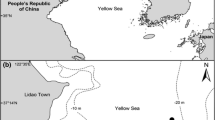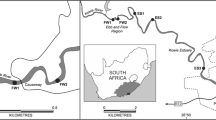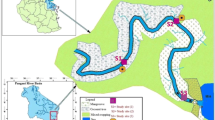Abstract
Predation of fish on their scyphozoan hosts has not been clearly defined using analysis of gut contents because gelatinous prey are difficult to visually detect and are dissolved by fixative solutions. Therefore, scyphomedusae have been generally considered not relevant in fish diet. To determine the contribution of their scyphozoan host tissue to the assimilated diet of age-0 Chloroscombrus chrysurus, we determined δ13C and δ15N of fish, their hosts (scyphomedusae Aurelia sp. and Drymonema larsoni) and their potential prey—small plankton (<200 μm) and mesozooplankton (>200 μm)—in the coastal waters of Alabama, USA. The diet of C. chrysurus was defined using the Bayesian mixing model Stable Isotope Analysis in R (SIAR). Models indicated that the scyphozoan hosts contributed on average ~90 % to fish assimilated diet. In contrast with previous dietary assessments based on analysis of gut contents, these results highlight that scyphozoans are important to the diet of fish associated with them. Because several ecologically and economically important fish species live in association with scyphomedusae, a redefinition of trophic links in marine food webs may be needed in light of the findings in this study.


Similar content being viewed by others
References
Arai MN (1988) Interactions of fish and pelagic coelenterates. Can J Zool 66:1913–1927
Arai MN (2005) Predation on pelagic coelenterates: a review. J Mar Biol Assoc UK 85:523–536
Arai MN, Welch DW, Dunsmuir AL, Jacobs MC, Ladouceur AR (2003) Digestion of pelagic Ctenophora and Cnidaria by fish. Can J Fish Aquat Sci 60:825–829
Bayha KM, Graham WM, Higgins JH III, Fletcher HA (2012) Predation potential of the jellyfish Drymonema larsoni Bayha & Dawson (Scyphozoa: Drymonematidae) on the moon jellyfish Aurelia sp. in the northern Gulf of Mexico. Hydrobiologia 690:189–197
Bjorndal K (1997) Foraging ecology and nutrition of sea turtles. In: Lutz PL, Musick JA, Wyneken J (eds) The biology of sea turtles. CRC Press, New York, pp 199–231
Brodeur RD (1998) In situ observations of the association between juvenile fishes and scyphomedusae in the Bering Sea. Mar Ecol Prog Ser 163:11–20
Carassou L, Dzwonkowski B, Hernandez FJ Jr, Powers SP, Park K, Graham WM, Mareska J (2011) Environmental influence on juvenile fish abundances in a river-dominated coastal system. Mar Coast Fish 3:411–427
Cardona L, De Quevedo IÁ, Borrell A, Aguilar A (2012) Massive Consumption of Gelatinous Plankton by Mediterranean Apex Predators. PLoS one 7:e31329
D’Ambra I (2012) Application of stable isotopes in the analysis of trophic interactions between jellyfish and fish. Dissertation, University of South Alabama
D’Ambra I, Carmichael RH, Graham WM (2014) Determination of δ13C and δ15N and trophic fractionation in jellyfish: implications for food web ecology. Mar Biol 161:473–480
Davenport J (1998) Sustaining endothermy on a diet of cold jelly: energetics of the leatherback turtle Dermochelys coriacea. Br Herpetol Soc Bull 62:4–8
Doyle TK, Houghton JDR, McDevitt R, Davenport J, Hays GC (2007) The energy density of jellyfish: estimates from bomb-calorimetry and proximate-consumption. J Exp Mar Biol Ecol 343:239–252
Fleming NEC, Houghton JDR, Magill CL, Harrod C (2011) Preservation methods alter stable isotope values in gelatinous zooplankton: implications for interpreting trophic ecology. Mar Biol 158:2141–2146
Fleming NEC, Harrod C, Griffin DC, Newton J, Houghton JDR (2014) Scyphozoan jellyfish provide short-term reproductive habitat for hyperiid amphipods in a temperate near-shore environment. Mar Ecol Prog Ser 510:229–240
Fossette S, Gleiss AC, Casey JP, Lewis AR, Hays GC (2012) Does prey size matter? Novel observations of feeding in the leatherback turtle (Dermochelys coriacea) allow a test of predator–prey size relationships. Biol Lett 8:351–354
González Carman V, Botto F, Gaitán E, Albareda D, Campagna C, Mianzan H (2014) A jellyfish diet for the herbivorous green turtle Chelonia mydas in the temperate SW Atlantic. Mar Biol 161:339–349
Grimes CB (2001) Fishery production and the Mississippi River discharge. Fisheries 26:17–26
Grimes CB, Finucane JH (1991) Spatial distribution and abundance of larval and juvenile fish, chlorophyll and macrozooplankton around the Mississippi River discharge plume, and the role of the plume in fish recruitment. Mar Ecol Prog Ser 75:109–119
Lucas CH, Pitt KA, Purcell JE, Lebrato M, Condon RH (2011) What’s in a jellyfish? Proximate and elemental composition and biometric relationships for use in biogeochemical studies. Ecology 92:1704
Lynam C, Brierley AS (2007) Enhanced survival of 0-group gadoid fish under jellyfish umbrellas. Mar Biol 150:1397–1401
Mansueti R (1963) Symbiotic behavior between small fishes and jellyfishes, with new data on that between the Stromateid, Peprilus alepidotus, and the Scyphomedusa, Chrysaora quinquecirrha. Copeia 1:40–80
McCutchan JHJ, Lewis WM Jr, Kendall C, McGrath CC (2003) Variation in trophic shift for stable isotope ratios of carbon, nitrogen and sulfur. Oikos 102:378–390
Mianzan H, Mari N, Prenski B, Sanchez F (1996) Fish predation on neritic ctenophores from Argentine continental shelf: a neglected food source? Fish Res 27:69–79
Mianzan H, Pajaro M, Colombo GA, Madirolas A (2001) Feeding on survival food: gelatinous zooplankton as a source food for anchovies. Hydrobiologia 451:45–53
Milisenda G, Rosa S, Fuentes VL, Boero F, Guglielmo L, Purcell JE, Piraino S (2014) Jellyfish as Prey: frequency of Predation and Selective Foraging of Boops boops (Vertebrata, Actinopterygii) on the Mauve Stinger Pelagia noctiluca (Cnidaria, Scyphozoa). PLoS one 9:e94600
Parnell A, Inger R, Bearhop S, Jackson AL (2010) Source partitioning using stable isotopes: coping with too much variation. PLoS one 5:e9672
Peterson BJ, Fry B (1987) Stable isotopes in ecosystem studies. Ann Rev Ecol Syst 18:293–320
Phillips PJ, Burke WD, Keener EJ (1969) Observations on the trophic significance of jellyfish in Mississippi sound with quantitative data on the associative behaviour of small fishes with medusae. Trans Am Fish Soc 4:703–712
Pitt KA, Welsh DT, Condon RH (2009) Influence of jellyfish blooms on carbon, nitrogen and phosphorus cycling and plankton production. Hydrobiologia 616:133–149
Post DM, Layman CA, Arrington DA, Takimoto G, Quattrocchi J, Montaña GC (2007) Getting to the fat of the matter: models, methods and assumptions for dealing with lipids in stable isotope analysis. Oecologia 152:179–189
Purcell JE (2012) Jellyfish and ctenophore blooms coincide with human proliferations and environmental perturbations. The Ann Rev Mar Sci 4:209–235
Purcell JE, Arai MN (2001) Interactions of pelagic cnidarians and ctenophores with fish: a review. Hydrobiologia 451:27–44
Purcell JE, Brown ED, Slokesbury KDE, Haldorson LH, Shirley TC (2000) Aggregations of the jellyfish Aurelia labiata: abundance, distribution, association with age-0 walleye pollock, and behaviors promoting aggregation in Prince William Sound, Alaska. Mar Ecol Prog Ser 195:145–158
Sal Moyano MP, Schiariti A, Giberto DA, Briz LD, Gavio MA, Mianzan HW (2012) The symbiotic relationship between Lychnorhiza lucerna (Scyphozoa, Rhizostomeae) and Libinia spinosa (Decapoda, Epialtidae) in the Río de la Plata (Argentina–Uruguay). Mar Biol 159:1933–1941
Shaw RF, Drullinger DL (1990) Early-life-history profiles, seasonal abundance, and distribution of four species of Carangid larvae off Louisiana, 1982 and 1983. NOAA Technical Report NMFS 89:44
Tolley SG (1987) Association of young Chloroscombrus chrysurus (Pisces:Ccarangidae)with the jellyfish Aurelia aurita. Copeia 1:216–219
Towanda T, Thuesen EV (2006) Ectosymbiotic behavior of Cancer gracilis and its trophic relationships with his host Phacellophora camtschatica and the parasitoid Hyperia medusarum. Mar Ecol Prog Ser 315:221–236
Vanderklift MA, Ponsard S (2003) Sources of variation in consumer-diet δ15N enrichment: a meta-analysis. Oecologia 136:169–182
Acknowledgments
Funding for this study was provided by the National Oceanographic and Atmospheric Agency (NOAA)—R.C. Shelby Center for Ecosystem-Based Fisheries Management, and the National Science Foundation NSF-RAPID (OCE-1043413) to WMG. We thank the Biological Oceanography and FOCAL laboratories at the Dauphin Island Sea Lab (Alabama, USA) for plankton collection. C. Culpepper, J. Herrmann, L. Linn, R. Shipplett, and K. Weiss provided invaluable help in the field. We appreciated the comments by Drs C. Harrod and JDR Houghton, which improved the submitted manuscript. This paper is dedicated to our dear friend and colleague Hermes Mianzan, who searched for jellyfish in fish stomachs during his whole but short life.
Author information
Authors and Affiliations
Corresponding author
Additional information
Communicated by C. Harrod.
Rights and permissions
About this article
Cite this article
D’Ambra, I., Graham, W.M., Carmichael, R.H. et al. Fish rely on scyphozoan hosts as a primary food source: evidence from stable isotope analysis. Mar Biol 162, 247–252 (2015). https://doi.org/10.1007/s00227-014-2569-5
Received:
Accepted:
Published:
Issue Date:
DOI: https://doi.org/10.1007/s00227-014-2569-5




